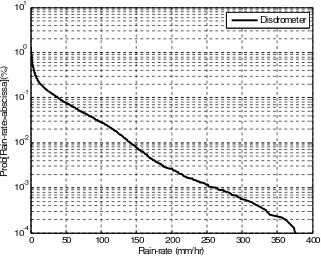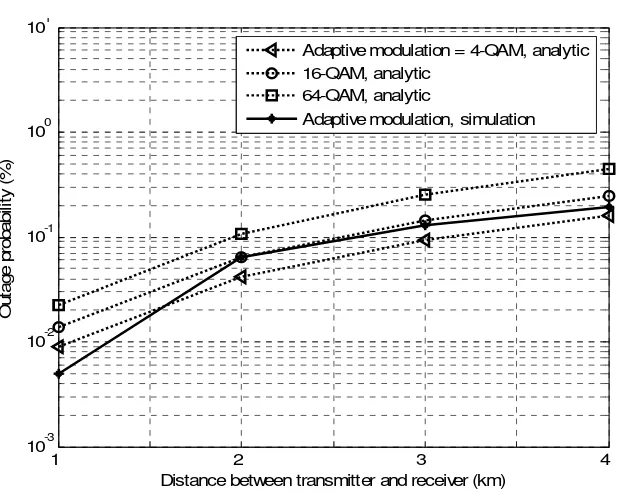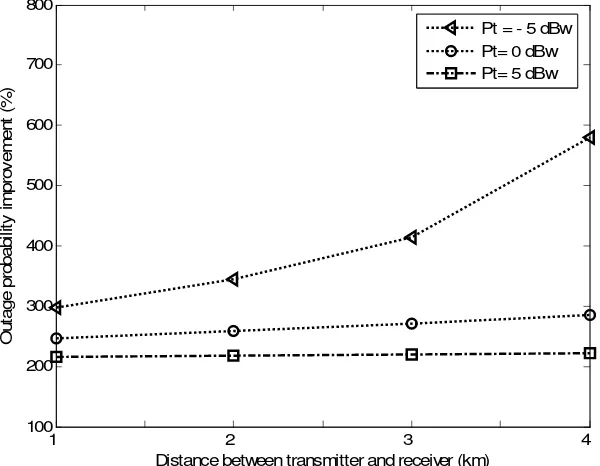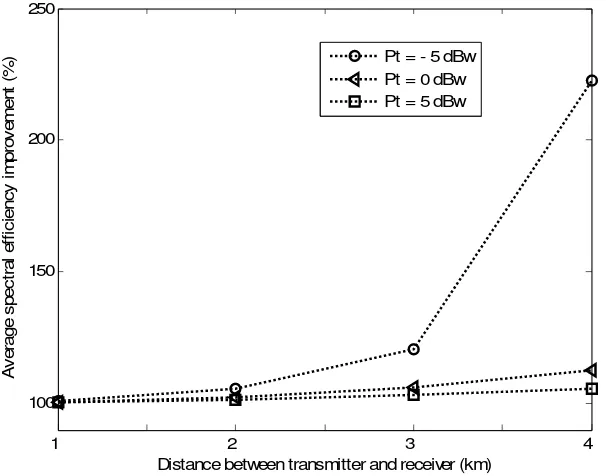An Adaptive Modulation in Millimeter-Wave
Communication System for Tropical Region
Suwadi1, Gamantyo Hendrantoro2 and Wirawan3
Department of Electrical Engineering, Institut Teknologi Sepuluh Nopember Surabaya Kampus ITS Sukolilo, Surabaya 60111, Phone/Fax. +62 31 5947302/5931237
e-mail : [email protected]; [email protected], [email protected]
Abstrak
Redaman hujan merupakan faktor propagasi yang dominan yang mempengaruhi outage dan efisiensi spektrum dari sistem komunikasi gelombang milimeter yang bekerja pada frekuensi 30 GHz. Modulasi adaptif diusulkan untuk meningkatkan kinerja sistem tersebut yaitu outage dan efisiensi spektrum. Makalah ini menjelaskan prosedur analitik untuk evaluasi outage dan efisiensi spektrum dari sistem tersebut di Indonesia, yang mempunyai curah hujan tinggi. Sebagai validasi, hasil analitik dibandingkan dengan hasil simulasi. Hasil penelitian menunjukkan bahwa modulasi adaptif dapat memperbaiki outage dan efisiensi spektrum sistem secara signifikan, khususnya untuk link dengan jarak jauh.
Kata kunci: efisiensi spectrum, gelombang millimeter, modulasi adaptif, redaman hujan
Abstract
The dominant propagation factor affecting the outage and the spectral efficiency of millimeter-wave communication systems operating at frequencies 30 GHz is rain attenuation. An adaptive modulation is proposed to improve the outage and spectral efficiency performance of the system. This paper presents an analytical procedure for the evaluation of the outage and spectral efficiency of the system in Indonesia with heavy rain rate. By comparing analytic and simulation a validation was conducted. The results show that adaptive modulation can significantly improve the outage and the spectral efficiency performance of the system, for links with long distance.
Keywords: adaptive modulation, millimeter-wave, rain attenuation, spectral efficiency
1. Introduction
The demand for broadband communication for high quality multimedia transmission is driving the use of higher radio frequency spectrum. Local multipoint distribution service (LMDS) [1] is a line of sight (LoS) point-to-multipoint broadband fixed wireless access system (BFWA) operating at millimeter-wave frequency. It is designed to deliver telecommunication and broadcast services (multimedia, video, internet, etc) from a central transmitter to individual subscriber within its cell size. The frequency bands allocated by ITU R and CEPT are usually above 20 GHz. In this band, rain attenuation is the most influential propagation factor to determine the system outage probability [2]. In such tropical countries as Indonesia very high rainfall intensities might cause significant attenuation in millimeter-wave communication system [3], [4].
2. Proposed Adaptive Modulation
In this paper, adaptive modulation technique is used to improve the outage and spectral efficiency of LoS millimeter-wave communication system in the presence of tropical rain attenuation, as shown in Figure 2. The system uses various modulation levels, i.e. 4, 16 and 64QAM, to appropriate channel condition that is affected by rain attenuationA. In clear sky conditions, the channel is only affected by Gaussian noise with power spectral density
N(W/Hz). The system uses 64-QAM so that it has maximum spectral efficiency of 6 bps/Hz and outage probability less than 0.01%.
Figure2 Adaptive modulation system
In rain conditions, the channel is affected by rain attenuation which causes the received signal-to-noise ratio γ to decrease, so the system has to use lower modulation level, i.e. 16-QAM or 4-16-QAM. In this research, perfect channel estimation is assumed. The feedback path will be assumed that it does not introduce any errors. The availability of channel information at the transmitter allows it to adapt its transmission scheme relative to the variation channel. The effects of feedback delay are ignored since in reality this delay is very small with respect to the rate of variation of rain attenuation. Bit error probability Pb for an AWGN channel with MQAM modulation and ideal coherent phase detection is bounded by [9], [11]
The threshold signal-to-noise ratio for targetPb:
5
with M denoting the modulation level. By using (2), thresholds of received signal-to-noise ratio th
γ can be obtained for each modulation level. Adaptation scenario for bit error probability 10-6 can be shown in Table 1.
Table 1. Adaptive M-QAM Scenario for Pb=10-6 Region ( j) Modulation Mode
3. Research Method
3.1 Rain measurement
For rain measurement, instrument was used to record, i.e. disdrometer. It was placed at the campus of Institut Teknologi Sepuluh Nopember (ITS) Surabaya, Indonesia (7o 13’ S, 112o 43’ E) since 2007. Rain rate has been measured until now. It was used to record rain rate data and then stored in a personal computer (PC) through RS232 and data sampling at every 10 s. In this research, it uses rain rate measurement data for 2 years. The R0.01 means that the rain rate at 0.01% of time in measured period that the rain-rate value is exceeded. Figure 1 shows that Surabaya Indonesia’s R0.01 is 140 mm/h, larger than that of non tropical area.
0 50 100 150 200 250 300 350 400
10-4 10-3 10-2 10-1 100 101
Rain-rate (mm/hr)
P
ro
b
[R
a
in
-r
a
te
>
a
b
s
c
is
s
a
](
%
)
Disdrometer
Figure 1 CCDFs of rain rate measurement result per year in Surabaya, Indonesia
In this paper, the use of adaptive modulation to improve the outage performance and average spectral efficiency is concentrated in millimeter-wave communication systems under the impact of tropical rain attenuation. To the best of the knowledge, this technique has never been studied for application in this condition. The technique will be explained in section 3.
In particular, analytical and simulation results of evaluation of outage probability and spectral efficiency in 30 GHz communication systems are presented.The simulation is done by applying the synthetic storm technique (SST) on rainfall intensity measurements in Surabaya, Indonesia and adopts ITU-R P.838-3 recommendation for calculating specific rain attenuation [10].
3.2 Clear Sky Signal to Noise Ratio
In this study, the key parameters of LMDS system used in ref. [12] are used. The transmitter and receiver antenna gains are 15 and 30 dBi, respectively. Accordingly, we compute signal to noise ratio clear sky condition for various transmitted powers and link lengths as shown in Table 2.
Table 2. Signal to Noise Ratio in Clear Sky Condition Transmit Power (dBw) Signal-to-noise ratio at clear sky condition γcs (dB)
1 km 2 km 3 km 4 km
-5 39.8 33.8 30.3 27.8
0 44.8 38.8 35.3 32.8
3.3 Rain Attenuation
In this research, the rain rate measurements recorded for 2 years in Surabaya (7013’ S, 112043’ E), Indonesia are used. Rain rate statistic R0.01 found from the measurement is 140 mm/h, larger than that of 100 mm/h suggested by ITU-R [9]. Rain attenuation was estimated by using synthetic storm technique (SST), which had been successfully tested for predicting long term statistics of fade duration [13]. Based on the rain attenuation estimates, it can be obtained mean µ and standard deviation σ of logarithm of rain attenuation of various link lengths as complementary cumulative distribution function (CCDF) of rain attenuation using (4). Figure 3 shows CCDFs of rain attenuation obtained using SST and analytically. The SST results can be approximated by the analytical at least for exceedance probabilities above 0.01%.
Table 3. Rain Attenuation Parameters of Mean and Standard Deviation
Rain attenuation parameters 1 km 2 km 3 km 4 km
1 2 3 4 10-3
10-2 10-1 100 101
Distance between transmitter and receiver (km)
O
u
ta
g
e
p
ro
b
a
b
ili
ty
(
%
)
Adaptive modulation = 4-QAM, analytic 16-QAM, analytic
64-QAM, analytic
Adaptive modulation, simulation
Figure 4 Outage probability of various link lengths with transmit power 0 dBw
3.4 Outage Probability
The outage probability is defined herein as the fraction of time where the signal-to-noise ratioγ falls below a specified thresholdγth :
(
th) (
cs th)
( cs th)out P P A P A
P = γ<γ = γ − <γ = ≥γ −γ (5)
where γcs and A respectively are signal-to-noise ratio (dB) in clear sky conditions and rain attenuation (dB). The final form of (5) can be computed using (4) with a=γcs−γth
3.5 Average Spectral Efficiency
In variable-rate modulation the data rate R[γ] is varied according to the signal to noise ratio γ. This can be done by fixing the symbol rate Rs=1/Ts of the modulation and using multiple modulation schemes, or by fixing the modulation (e.g. 4QAM) and changing the symbol rate. In contrast, changing the modulation type with a fixed symbol rate is fairly easy, and these techniques are used in current systems [9]. When a discrete set of modulation types is used each value of γ must be mapped into one of the possible modulation schemes. This is often done to maintain the bit error probability of each scheme below a given value. To maintain the targetPb the modulation level M and constant power are adjusted. The average spectral efficiency for this discrete rate policy is just the sum of the data rates associated with each of the regions multiplied by the probability that γ falls in the region. The average spectral efficiency can be calculated by:
∑
−∫
=
γ
γ +
γ γ =
1
1 2 max
1
) ( ) ( log ]
[ j
j
i M
j
j p d
M C
E (6)
(
)
P =10-6. The analytically outage probability for various modulation modes with transmitted power 0 dBw is obtained as shown in Figure 4. Adaptive modulation and fixed 4-QAM have the least outage probability, if they are compared with fixed 16-QAM and 64-QAM.
4. Results and Discussion
It is defined herein outage probability improvement as outage probability of fixed 64-QAM divided by that of adaptive modulation. Figure 5 shows that outage probability can improve more than 200% for various link lengths and transmitted powers, when adaptive modulation is used. Outage performance can improve significantly at long distance with low transmit power, e.g., at 4 km link with transmit power -5dBW. In this case, the clear sky signal-to-noise ratio γcs is slightly higher than γth of adaptive modulation. Furthermore, as far as outage performance is concerned, adaptive modulation mode with low transmitted power seems to be more suitable.
1 2 3 4
Distance between transmitter and receiver (km)
O
Figure 5 Outage probability improvements of various link lengths for several transmitted powers
Figure 6 shows analytical average spectral efficiency of various modulation modes for several link lengths and simulation result for adaptive modulation. The agreement between the analytical and simulation results seems to be quite good and indicative of the validation of the proposed procedure. Adaptive modulation system has shown the biggest average spectral efficiency among various modulation modes.
1 2 3 4
Distance between transmitter and receiver (km)
A
Figure 6 Average spectral efficiency of single link for Pb=10 -6
Distance between transmitter and receiver (km)
A
Figure 7 Average spectral efficiency improvement of various transmitted powers
5. Conclusions
cell border. For these subscribers the received power is relatively low, which makes their reception quality more vulnerable to rain attenuation.
Acknowledgement
The reported work was supported by Directorate General of Higher Education (DGHE), Ministry of National Education, Republic of Indonesia.
References
[1] C. Smith, LMDS, New York: McGraw-Hill, 2000.
[2] A. Paraboni, G. Masini, and A. Elia, “The effect of precipitation on microwave LMDS networks-performance analysis using a physical rain cell model”, IEEE J. Selected Areas Comm,. Vol. 20, No.4, pp. 615-619, April, 2002.
[3] M. Salehudin, B. Hanantasena, L.J.M. Wijdemans, “Ka-band line of sight radio propagation experiment in Surabaya Indonesia”, Fifth Ka-band Utilization Conf., Taormina, Italy, pp. 161-165, Oct. 1999.
[4] A. Mauludiyanto, G. Hendrantoro, M.H. Purnomo, T. Ramadhany and A. Matsushima, “ ARIMA modelling of tropical rain attenuation on a short 28-GHz terrestrial link ”, IEEE Antennas and Wireless prop. Letter, Vol. 9, pp.223-227, 2010.
[5] D. G. Sweeney, and C. W. Bostian, “Implementing adaptive power control as a 30/20 GHz fade countermeasure”, IEEE Transactions on Antenna and Propagation, Vol. 47, No.1, pp. 40-46, January, 1999.
[6] G. Hendrantoro, R.J.C. Bultitude, and D.D. Falconer, “Use of cell-site diversity in millimeter-wave fixed cellular systems to combat the effects of rain attenuation”, IEEE J. Select. Areas Commun., vol. 20, No.3, pp. 602-614, 2002.
[7] A. D. Panagopoulos and J. D. Kanellopoulos, “Cell-site diversity performance of millimeter-wave fixed cellular system operating at frequency above 20 GHz”, IEEE Antennas and Wireless Propagation Letters, Vol. 1, pp. 183-185, 2002.
[8] S. T. Chung, and A. J. Goldsmith, “Degrees of freedom in adaptive modulation: A Unified view”, IEEE Transactions on Communications, Vol. 49, No.9, pp. 1561-1571, September , 2001.
[9] A. J. Goldsmith, “Wireless Communications”, Cambridge University Press, 2005.
[10] ITU-R Rec. P.838-3, “Specific attenuation model for rain for use in prediction methods”, 2005.
[11] Sklar. “Digital Communication”, Prentice Hall, New Jersey, 1994.
[12] Chu, C. Y., Chen, K. S. “Effects of rain fading on the efficiency of the Ka-Band LMDS system in the Taiwan area”, IEEE Transactions on Vehicular Technology, vol. 54, no. 1, pp. 9-19. January, 2005





